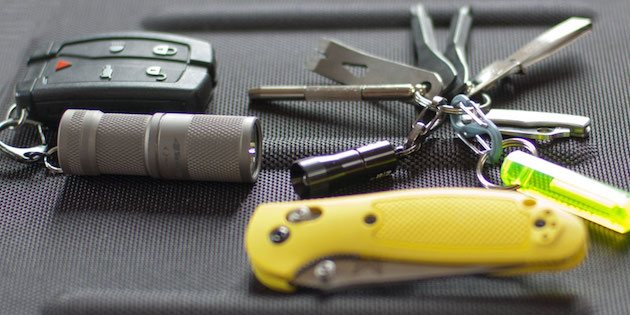Seems like the UK has very strict control over carrying knives in public places. And I’m OK with that.
But it really restricts the every day carry ability to be prepared for when SHTF, right?
According to the HM Gov website, here is what you cannot carry in public, without good reason, in the UK. Unless you want to risk four years as His Majesty’s guest plus an unlimited fine.
Knives
What knives are illegal in the UK? Probably all that are of any use in a survival situation.
Any knife with a blade over three inches long. (75mm)
Any folding knife with a blade of any length that can be locked in the open position and can only be folded by pressing a button.
Multi-tools
Some multi-tools are considered ‘lock-knives’ so be careful here.
Balisongs – Butterfly Knives
Butterfly knives are illegal in the UK, known as ‘balisongs’ and originated in the Philippines. They have the blade enclosed by the handle which is split down the middle to reveal the blade. With practice, a person could deploy a butterfly knife very quickly making it an ideal concealed weapon.
Disguised Knives
Any knife that has a concealed blade and is designed to appear as an everyday object normally carried in a handbag or briefcase such as a comb, lipstick, or writing instrument.
Flick Knives
A knife with a blade that springs out from the handle when a button is pressed.
Gravity Knives
A knife with a blade contained in its handle that opens by inertia or gravity, so that it can be opened and closed one-handed.
Originating in Germany during World War Two and issued to German paratroopers to cut themselves free when tangled in their parachutes.
Stealth Knife
A knife with a blade made from a non-ferrous material and therefore not detectable with metal detectors. Ceramic knives used in food preparation could maybe, probably be OK if you were a chef on your way to work.
Zombie Knives
Knives having long blades with serrated edges and decorated with images or words depicting violence. The blades could be up to 25 inches long. (630mm)
Swords
A long-bladed weapon with a curved blade over 20 inches in length. (500mm)
Sword Sticks
A hollow walking stick or cane containing a blade which may be used as a sword
Belt Buckle Knife
A belt buckle that incorporates or conceals a knife.
Push Daggers
A knife that has a handle that can be held within a clenched fist with the blade protruding between two fingers.
Not Knives but still Illegal
Blowpipes
A hollow tube through which hard pellets or darts can be projected by use of breath or pressurized air.
Truncheons or Batons
Not a knife, but a cylindrical club made of hardwood, metal, or rubber with a molded or wrapped grip with a thicker shaft and rounded tip.
Other designs include a side handle perpendicular to the shaft.
Telescopic Truncheons
Not a knife, but a truncheon or baton that extends automatically by pressing a button or releasing a spring in the handle.
Kubotans
Usually part of a keychain. Made of high-impact plastic or stainless steel, approx 6 inches (150mm) long, half inch (12mm) in diameter with a screw eye or swivel with key ring attached at one end.
Shuriken
Ninja show at Iga Ninja Museum, Ueno, Japan
A throwing weapon. Known as ‘throwing stars’ or ‘ninja stars’. A plate with sharp radiating points. Modern shuriken are made from stainless steel.
Kusari-gama
A length of rope or chain with a sickle fastened at one end.
(A sickle is a one-handed agricultural tool used in harvesting with a curved blade.)
Kyoketsu-shoge
Similar to the kusari-gama but the sickle replaced by a Hooked-knife
Manriki-kusari
A length of rope, wire or chain fastened at each end to a hard weight or a hand grip.
Hand or Foot-claws
A band of metal wrapped around the hand or strapped to the foot with several protruding sharp spikes.
Knuckledusters
Pieces of metal shaped to fit around the knuckles. Used in hand-to-hand combat. Concentrates the force of the blow to a smaller contact area while at the same time distributing the counter-force across the assailant’s palm rather than across the fingers.
Reasonable Reasons for Carrying Offensive Weapons
There are some legitimate reasons for carrying illegal weapons in public. But for me, I wouldn’t push my luck. Especially in these uncertain times.
- Taking knives you use at work to work
- Taking the item to a gallery or museum to be exhibited.
- If it’s going to be used for theatre or filmmaking
- Taking it somewhere to teach someone how to use it. (Seems a bit counter-productive to me.)
And remember it’s the court will decide whether your reason for carrying an illegal weapon is justified or not.
Here are Some Sobering Statistics
In the year ending March 2020, there were approximately 46,000 offences involving a knife or sharp instrument in England and Wales. And it doesn’t look like that number is getting smaller
In England and Wales for the year ending March 2019, there were over 20,000 robberies, 480 rapes, 190 sexual assaults and 250 homicides involving a knife or sharp instrument.
In Conclusion
I’m quite OK with making offensive weapons illegal. The range of vicious knives shown above were used on the (Japanese) battlefield in medieval times and today can only be justified if you’re going to fight a few zombies.
However, when SHTF and infrastructures around us fail, we will need sharp instruments to survive, so select with care and keep your survival knife of choice, clean, sharp and secure in your grab bag.
Henry

Leave a Reply